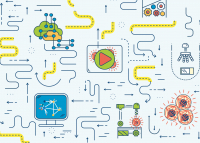 NOTÍCIES
NOTÍCIES
The latest trends in biomedical research meet up in Barcelona
- The Centre for Genomic Regulation (CRG) hosted its 17th Annual Symposium on 27th and 28th September. The event focused on new state-of-the-art technologies that are reshaping research in biology.
- The symposium covered recent discoveries, methods, technologies and approaches including single molecule and real time imaging techniques, single cell genomics, genome and organoid engineering, DNA modification and synthetic virology and biology.
- Pamela Silver, from Harvard Medical School and the Wyss Institute; Anthony Hyman, director of the Max Planck Institute of Molecular Cell Biology and Genetics in Dresden; Holger Stark, director of the Max Planck Institute for Biophysical Chemistry; and Osamu Nureki, from the University of Tokyo, are some of the outstanding invited speakers.
The Centre for Genomic Regulation (CRG) hosted its 17th CRG Symposium titled “Trends in Biology: cutting edge techniques from genomes to organisms” on 27th and 28th September at the PRBB in Barcelona. The meeting, organized by a committee of young CRG researchers including PhD students and postdoctoral researchers, was focused on new state-of-the-art technologies that are reshaping biomedical research.
Scientific advances depend to a large extent on technological advances so, this meeting will explore how current technologies might shape our future way of thinking about biological problems. The meeting brought top leading international scientists to interact with the global and local scientific community to share ideas, discuss results and debate on this amazing topic.
A number of themes were covered, including: single molecule and real time imaging techniques, single cell genomics, genome and organoid engineering, DNA modification and synthetic virology and biology. The symposium was organized in the following sessions:
Session 1: Molecules in high resolution
Single molecule and real time imaging techniques are perhaps modern imaging technologies that have had the strongest impact on the field of cell biology, and might continue to do so. The trend is to label and monitor molecules, organelles and cells and their interactions, using increasingly sophisticated tools, in real time. These images are beginning to change our views of the dynamic nature of some of the most fundamental cell biological processes.
In this session, Holger Stark, director of the Max Panck Institute for Biophysical Chemistry, presented his experience determining three-dimensional structures of macromolecules with the single particle electron Cyomicroscopy technique (Cryo-EM). His team broke the resolution barrier of 0.3 nanometers for the first time and were able to observe ribosomes at an unprecedented level of detail, which may have important implications to our current understanding of, for example, how antibiotics act on the ribosome.
Session 2: The inner life of the cell
Single-cell analysis are being more and more common in many research projects. This technique spans classical cell biology, developmental biology, genomics and computational biology.
Prof. Anthony Hyman, director of the Max Plank Institute of Molecular Cell Biology and Genetics, was one of the highlighted speakers in this session. He shared his research on how microtubules, which are structures of the cell cytoskeleton, control cell division and cell polarity.
Session 3: Genome and organoid engineering
Organoids – the 3D self-organizing structures produced in vitro from pluripotent or somatic stem cells that show realistic micro-anatomy – can recapitulate many aspects of structural organization and functionality of their in vivo organ counterparts, thus holding great promise for biomedical research and translational applications. Importantly, faithful recapitulation of disease and development processes relies on the ability to modify the genomic contents in organoid cells. The revolutionary genome engineering technologies, including CRISPR/Cas9, are enabling investigators to generate various reporter cell lines at a fast pace for screening disease-associated mutations for disease modeling as well as for validation of specific cell lineages.
Prof. Osamu Nureki, from the Institute of Medical Science in the University of Tokyo explored the molecular mechanism of CRISPR as a genome editing tool towards medical applications. In a paper published in Science a few days ago, he expanded the targeting space CRISPR-Cas9, which allows this new genome engineering toolbox to be useful in a broader range of applications, from basic research to clinical therapeutics.
Session 4: Building and understanding complex systems
Synthetic biology, the convergence of advances in chemistry, biology, computer science, and engineering, is a biology-based “toolkit” that uses abstraction, standardization, and automated construction to change how we build biological systems and expand the range of possible products. Its breakthroughs will speed the development of biologically engineered solutions to pressing global problems related to health, materials, energy, environment, and security.
Prof. Pamela Silver, founder of the Systems Biology Department at Harvard Medical School, will talk about her research in systems and synthetic biology for health and the environment.
17th CRG Symposium “Trends in biology: cutting edge techniques from genomes to organisms” http://www.crg.eu/symposium2018
Dates: 27th and 28th September 2018
Organizers: CRG PhD students and Postodcs organizing committee (Ruggero Cortini, Marco Di Stefano, Rosa Fernández, Tobias Hoffmann, Alejandra Laguillo, and Estefania Mancini)
Venue: PRBB Auditorium, Doctor Aiguader 88, 08003 Barcelona.
For further information and media requests please, contact:
Laia Cendrós, media relations, Centre for Genomic Regulation (CRG) – Tel. +34 933160237
| Attachment | Size |
|---|---|
| 170.37 KB | |
| 171.35 KB | |
| 211.42 KB |

